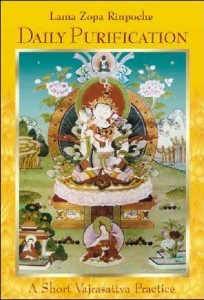
Daily Purification – A Short Vajrasattva Practice is an instruction from Lama Zopa Rinpoche on a short Vajrasatta meditation called Purification with the Four Opponent Powers. The practice is based upon the merits of Buddhist teacher Atiśa Dipankara Shrijnana born in 980 in Bangladesh. He was a major figure in the establishment of the Sarma lineages in Tibet. In the work Liberation in the Palm of Your Hand, by Pabongka Rinpoche, it is explained how Atiśa Dipankara would purify any negativity, no matter how small, immediately. Even in public or when riding his horse, as soon as he noticed a breach of his ethics, he would stop what he was doing, drop to one knee and then and there, purify it with the four opponent powers—the powers of dependence, regret, remedy and restraint. Download the instructions here (26 pages pdf ebook):
Daily Purification A Short Vajrasattva Practice
Who is Vajrasattva?
Vajrasattva (or Vajrasattva) is a significant figure in Tibetan Buddhism and Vajrayana Buddhism. He embodies the purity aspect of the enlightened mind, helping to purify the karma of the practitioner. Often depicted in art and meditation practices, Vajrasattva is associated with purification. It also is seen as a means for practitioners to purify their negative actions, impurities, and obstacles to spiritual growth.
Vajrasattva is typically represented in a white color, symbolizing purity, and holds a vajra (thunderbolt) and a bell, representing the union of wisdom and compassion, the two key aspects of Buddhist enlightenment. In Tibetan Buddhism, the practice of Vajrasattva meditation and mantra recitation is a common preliminary practice, serving as a foundational tool for spiritual purification and preparation for more advanced practices. This practice is often undertaken as part of the preliminary practices known as Ngondro, where practitioners recite the 100-syllable Vajrasattva mantra to purify their negative karma.

